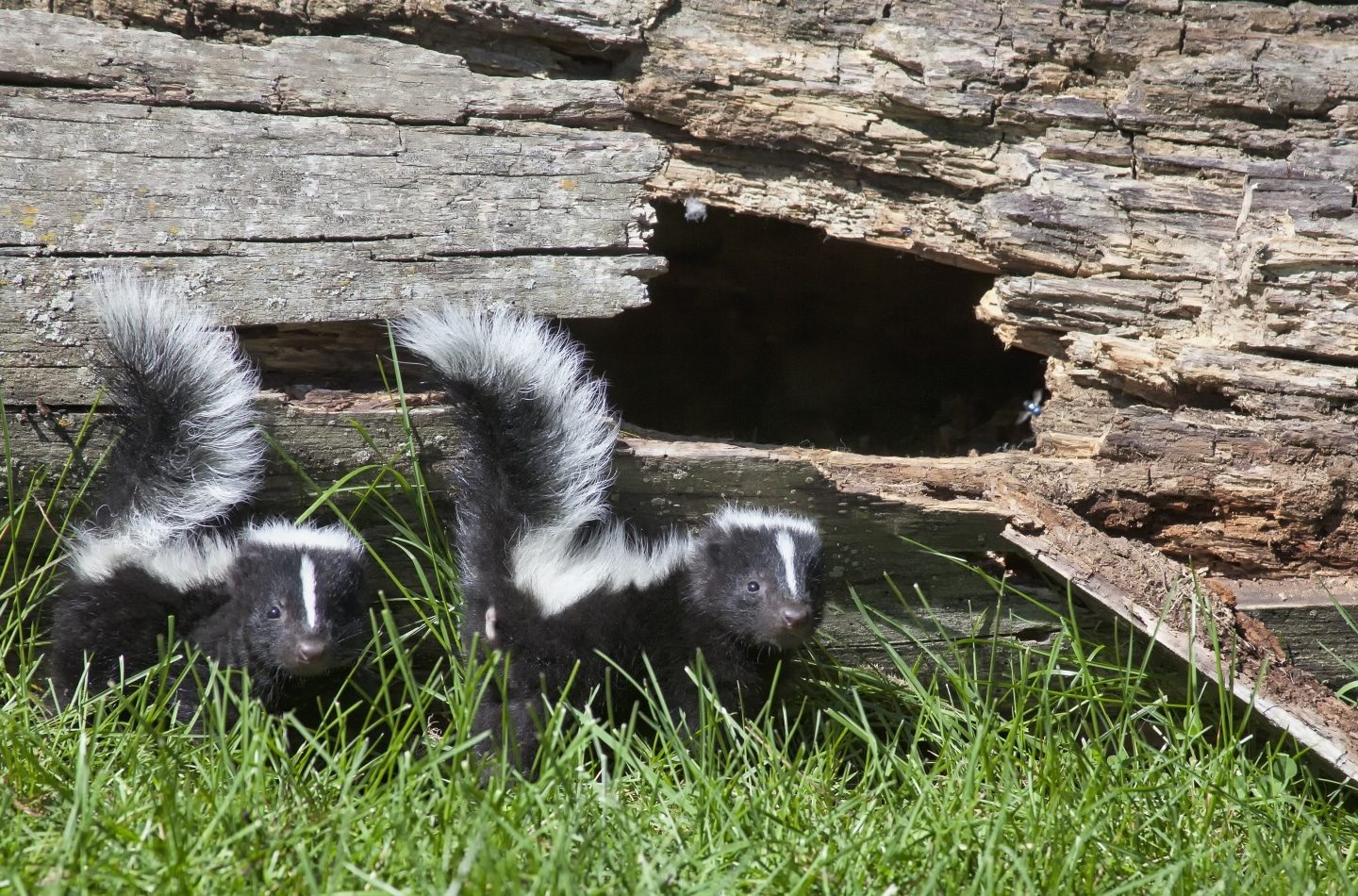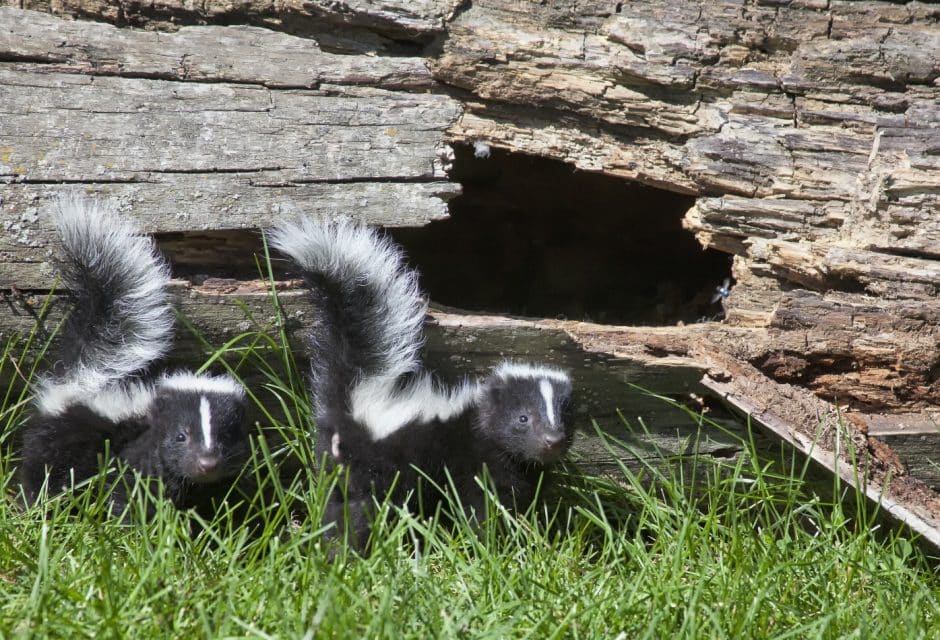

What To Do About Skunks
Why they're not really worth raising a stink over
Skunks are infamous producers of an odor so powerful that it quickly and easily communicates a clear message: “Don’t mess with me.” Although known mostly for its robust smell, the chemical can also cause intense discomfort if it gets into a person's or animal’s eyes. Fortunately, the skunk’s characteristic black and white coloring is so recognizable that most potential victims have fair warning. Though blending into the landscape is a more common form of protection in the wild, being so distinguishable is generally beneficial to skunks because it can dissuade many wild animals, and the occasional dog with more than half a brain, from attacking.
Common conflicts and solutions
It is more likely you will smell a skunk than see one. Persistent, faint musk smells under a building or woodpile may suggest that a skunk has taken up residence. You should look for other clues as well because foxes also have their own musky scent that may cause misidentification.
You may find small, shallow holes in the lawn, similar to those made by squirrels, which are a result of a skunk foraging for grubs.
Occasionally you may also find plants knocked over or damage to the lower leaves or ears of ripening garden crops, including corn.
Occasionally a skunk will wander into an open garage or shed, a compelling reason to secure all outbuildings.
Skunk encounters
Occasional skunk sightings in a neighborhood are not a cause for alarm. Because skunks are generally easy-going, they will not intentionally bother people. In fact, skunks may benefit humans by eating many insects and rodents many regard as pests.
Warning signs to heed
Skunks use their powerful defense only when they or their young are threatened and cannot escape. Even then, they give ample warning that should be heeded—stamping front feet, a raised tail, hissing, short forward charges, and, especially, twisting the hind end around in your direction.
Spotted skunks will even contort into a characteristic handstand, rump in the air with eyes still fixed on the threat.
Move away slowly and quietly. By nature, dogs tend to ignore these warnings, so it is important they be restrained for their own good.
Tolerance
Because of the lingering odor, and fear of being sprayed it may be hard for some people to tolerate skunks living under a deck or old shed. But skunks need such shelter when they are most vulnerable (during the coldest parts of the winter and when raising young).
How many skunks are killed each year simply because of fear is not known, but it is surely a large number. This is unfortunate because it is common knowledge among those who work closely with these animals, that it actually takes a lot to get sprayed.
The nocturnal habits of skunks, their unaggressive nature , and the generally beneficial role they play in nature by consuming insects and rodents are all good reasons to leave them alone until they have moved on their own accord (which they readily do) or can safely be harassed away from an area where they are not wanted.
Protecting your yard
Habitat modification
Skunks are attracted to things like garbage and pet food left out at night and convenient denning sites, such as wood and rock piles, elevated sheds, openings under concrete slabs and porches, and access to crawl spaces under houses.
Preventive measures, such as removing attractants around houses, will decrease the likelihood of an unpleasant skunk encounter. This includes securing trash, feeding pets indoors, or if fed outdoors, removing food immediately after pets eat.
Skunks also dig for grubs in lawns when wet soil conditions push grubs close to the surface. When the soil dries, the grubs move deeper, so the problem can generally be stopped or prevented in the first place by not overwatering lawns.
Preventing denning (exclusion)
Exclusion techniques should be used proactively to prevent denning before an animal moves in.
A suspected skunk den should first be checked to determine if it has a current resident.
This may be done by loosely filling the hole (or holes) with soil, leaves, straw, crumpled paper, or similar material. If a skunk is present, the animal will easily push his way out overnight and reopen the hole.
If the plug remains undisturbed for two or three nights (and it is not winter, when the skunk may be inactive for long periods), it is safe to assume that the hole is unoccupied and can be filled. Permanently exclude skunks (and other den-seeking creatures) with an L-shaped footer of welded wire or similar barriers.
If a skunk is using the den, either harassment or eviction using a one-way door system is recommended. It is imperative to be sure that dependent young are not present. When in doubt, assume they are and consider using the door after they start following their mother to forage. Leave the door in place for two or three nights to a week to be sure the skunk has left.
Harassment
When it is safe to displace skunks, mild harassment can be very effective.
This can be as simple as loosely repacking the den hole with leaves or straw or other material to see if the skunk gets the message and moves elsewhere.
A couple of hours before dusk, adding light and noise to make an attractive (dark, quiet) space unattractive may help as well. Make sure the skunk is not close by before placing the disturbing stimulus.
About repellants
Repellants may also be effective. Mild repellents, such as used kitty litter, can be placed near or inside the den to one side so the skunk has to pass them to get out; commercial or homemade capsaicin or castor oil repellents may also be tried.
Some repellents that are advertised and sold to deter skunks from yards are predator urine products that we believe are inhumane and inappropriate for use.
Others, such as the powerful capsaicin-based “hot sauces,” must be used with extreme care because of the consequences for both people and pets who may inadvertently come into contact with them.
Skunk in garage
Skunks who have wandered into a garage can simply be allowed to wander back out by making sure the door is open before dusk. Skunks are nocturnally active, so opening the door at dusk and closing it later in the evening is likely to be a solution to this problem.
It is important to make sure the skunk has not been coming and going for long enough to have established a den and given birth, and that any accessible foods (bags of bird seed, for example) have been moved and secured in tightly sealed containers.
Removal from a window well
It is not uncommon for a skunk, thanks to weak eyesight, to stumble into a window well and become trapped because of their poor climbing abilities. If a skunk becomes trapped in a window well or similar steep-sided pit, provide a means of escape.
Place a rough board (or one with cleats, carpet, toweling, chicken wire, or other material to give the animal traction) that is long enough to serve as a ramp out of the well. Skunks are poor climbers, so the board should lean no steeper than a 45-degree angle.
Trying to stay out of sight of the skunk, slowly and carefully lower the board. If possible, a second person with a vantage point high enough to see the skunk (perhaps from an upstairs window) can warn of any signs of agitation.
Another method of placing the board is to tie it to the end of a long pole and lower it by holding the opposite end of the pole. Once the board is placed, keep people and pets away from the area until nightfall, when the skunk should leave.
If the skunk cannot climb out due to the well’s depth or steepness, the Connecticut Wildlife Rehabilitators Association recommends a technique it uses that involves a plastic rectangular garbage can and smelly cheese. Place the cheese at the bottom of the can and lower it on its side with the open end facing the skunk. Once the skunk enters and begins to dine, carefully tilt the can up a bit, raising it elevator style out of the window well, then gently tip it on its side again so the skunk can amble out.
Regardless of how you end up getting the skunk out, prevent the situation from recurring by installing covers over window wells.
Is that skunk rabid?
Even though skunks are mostly active at night, they sometimes look for food by day—particularly in the spring, when they have young and may be extra hungry. Don’t be concerned if you see an adult skunk in the daytime unless she is also showing abnormal behaviors:
- Limb paralysis.
- Circling.
- Boldness or unprovoked aggression.
- Disorientation, staggering.
- Uncharacteristic tameness.
- Don’t approach the skunk yourself. Call your local animal control officer, wildlife rehabilitator, health department, or police department for assistance.
- There are amazingly few books devoted to skunks or descriptive of their natural history as we like to recommend here. We hope that will change.
- If you are located within the D.C. Metro Area, take advantage of our wildlife conflict resolution service. Learn More
- Purchase a copy of Wild Neighbors; the go-to guide for useful, humane solutions to conflicts with wildlife.
Join the newsletter and never miss out on dog content again!
"*" indicates required fields
By clicking the arrow, you agree to our web Terms of Use and Privacy & Cookie Policy. Easy unsubscribe links are provided in every email.





